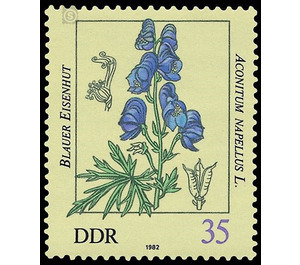poisonous plants - Germany / German Democratic Republic 1982 - 35 Pfennig
Theme: Flora
| Country | Germany / German Democratic Republic |
| Issue Date | 1982 |
| Face Value | 35.00 |
| Color | multi-colored |
| Perforation | K 14 |
| Printing Type | offset |
| Stamp Type | Postage stamp |
| Item Type | Stamp |
| Chronological Issue Number | 2437 |
| Chronological Chapter | GER-DDR |
| SID | 868157 |
| In 20 Wishlists | |
Poisonous Plants With the illustrations of poisonous plants, the Ministry of Posts and Telecommunications of the German Democratic Republic issues six multicolored special postage stamps. Special cancellation from April 6 to June 5, 1982 Poisonous plants "All things are poison, and nothing is without poison; but the dose makes that a thing is not a poison. "Theophrastus Bombastus of Hohenheim, gen. Paracelsus (1493-1541) wrote this statement in the light of the gradual transition from spice and medicinal to poisonous plants and the beneficial effects of such a plant the hand of the doctor whose uncontrolled use or misuse may be fatal.Various poisonous plants are extremely beautiful, show bright colors in flowers and fruits, or are so rare that we need to protect them.Their number is legion and in the plant world Of our native flora we have about 135 more or less poisonous plants, not counting the ornamental plants.Not all are deadly poisonous, but each affects the health considerably 35-pfennig value: Blue Iron Hat Up to 1,5 m the axis of this protected one rises Buttercup family (Ranunculaceae) with strongly divided leaves The blue-violet monosymmetric flowers have one peculiar helmet, which is formed by one of the Kronblattähnlich developed sepals. The flowers are in end grapes or in racemose inflorescences in the axils of the uppermost leaves. The plant contains various alkaloids, i.a. Aconitin, which is one of the strongest plant toxins. A poisoning manifests itself in sweating, shivering, colic, diarrhea, temperature drop to respiratory and cardiac paralysis.


